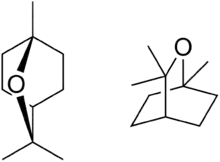Eucalyptol
 | |||
| |||
| Names | |||
|---|---|---|---|
| IUPAC name
1,3,3-Trimethyl-2-oxabicyclo[2.2.2]octane | |||
| Other names
1,8-Cineole 1,8-Epoxy-p-menthane cajeputol 1,8-epoxy-p-menthane, 1,8-oxido-p-menthane eucalyptole 1,3,3-trimethyl-2-oxabicyclo[2.2.2]octane cineol cineole. | |||
| Identifiers | |||
CAS Number |
|||
3D model (JSmol) |
|||
Beilstein Reference |
105109 5239941 | ||
| ChEBI | |||
| ChEMBL | |||
| ChemSpider | |||
| DrugBank | |||
| ECHA InfoCard | 100.006.757 | ||
| EC Number |
| ||
Gmelin Reference |
131076 | ||
| KEGG | |||
PubChem CID |
|||
| UNII | |||
CompTox Dashboard (EPA) |
|||
InChI
| |||
SMILES
| |||
| Properties | |||
Chemical formula |
C10H18O | ||
| Molar mass | 154.249 g/mol | ||
| Density | 0.9225 g/cm3 | ||
| Melting point | 2.9 °C (37.2 °F; 276.0 K) | ||
| Boiling point | 176–177 °C (349–351 °F; 449–450 K) | ||
Magnetic susceptibility (χ) |
−116.3×10−6 cm3/mol | ||
| Pharmacology | |||
| R05CA13 (WHO) | |||
| Hazards | |||
| GHS labelling: | |||
Pictograms |
    | ||
Signal word |
Danger | ||
Hazard statements |
H226, H304, H315, H317, H319, H411 | ||
Precautionary statements |
P210, P233, P240, P241, P242, P243, P261, P264, P272, P273, P280, P301+P310, P302+P352, P303+P361+P353, P305+P351+P338, P321, P331, P332+P313, P333+P313, P337+P313, P362, P363, P370+P378, P391, P403+P235, P405, P501 | ||
Except where otherwise noted, data are given for materials in their standard state (at 25 °C [77 °F], 100 kPa).
Infobox references | |||
Eucalyptol is a monoterpenoid. A colorless liquid, it is a bicyclic ether. Eucalyptol has a fresh mint-like smell and a spicy, cooling taste. It is insoluble in water, but miscible with organic solvents. Eucalyptol makes up 90% of eucalyptus oil.[1] Eucalyptol forms crystalline adducts with hydrohalic acids, o-cresol, resorcinol, and phosphoric acid. Formation of these adducts is useful for purification. [2]
In 1870, F. S. Cloez identified and ascribed the name "eucalyptol" to the dominant portion of Eucalyptus globulus oil.[1]
Uses
Because of its pleasant, spicy aroma and taste, eucalyptol is used in flavorings, fragrances, and cosmetics. Cineole-based eucalyptus oil is used as a flavouring at low levels (0.002%) in various products, including baked goods, confectionery, meat products, and beverages.[3] In a 1994 report released by five top cigarette companies, eucalyptol was listed as one of the 599 additives to cigarettes.[4] It is claimed to be added to improve the flavor.
Eucalyptol is an ingredient in commercial mouthwashes, and has been used in traditional medicine as a cough suppressant.[5]
Other
Eucalyptol exhibits insecticidal and insect repellent properties.[6][7]
In contrast, eucalyptol is one of many compounds that are attractive to males of various species of orchid bees, which gather the chemical to synthesize pheromones; it is commonly used as bait to attract and collect these bees for study.[8] One such study with Euglossa imperialis, a nonsocial orchid bee species, has shown that the presence of cineole (also eucalyptol) elevates territorial behavior and specifically attracts the male bees. It was even observed that these males would periodically leave their territories to forage for chemicals such as cineole, thought to be important for attracting and mating with females, to synthesize pheromones.[9]
Toxicology
It has low toxicity (hence its use in foods), with an LD50 of 2.48g/kg (rabbits).
List of plants that contain eucalyptol
- Aframomum corrorima[10]
- Artemisia tridentata[11]
- Cannabis[12]
- Cinnamomum camphora, camphor laurel (50%)[13]
- Eucalyptus cneorifolia
- Eucalyptus dives
- Eucalyptus dumosa
- Eucalyptus globulus[14]
- Eucalyptus goniocalyx
- Eucalyptus horistes
- Eucalyptus kochii
- Eucalyptus leucoxylon
- Eucalyptus largiflorens [15]
- Eucalyptus oleosa
- Eucalyptus polybractea
- Eucalyptus radiata
- Eucalyptus rossii
- Eucalyptus sideroxylon
- Eucalyptus smithii
- Eucalyptus staigeriana[16]
- Eucalyptus tereticornis
- Eucalyptus viridis
- Hedychium coronarium, butterfly lily[17][18][19][20]
- Helichrysum gymnocephalum[21]
- Kaempferia galanga, galangal, (5.7%)[22]
- Laurus nobilis, bay laurel, (45%)
- Melaleuca alternifolia, tea tree, (0–15%)
- Salvia lavandulifolia, Spanish sage (13%)[23]
- Turnera diffusa, damiana[24]
- Umbellularia californica, pepperwood (22.0%)[25]
- Zingiber officinale, ginger [26]
Compendial status
N.B. Listed as "cineole" in some pharmacopoeias.
See also
- Camphor
- Citral
- Eucalyptus oil
- Lavandula
- Menthol
- Mouthwash
References
- Boland, D. J.; Brophy, J. J.; House, A. P. N. (1991). Eucalyptus Leaf Oils: Use, Chemistry, Distillation and Marketing. Melbourne: Inkata Press. p. 6. ISBN 0-909605-69-6.
- Eggersdorfer, Manfred (2000). "Terpenes". Ullmann's Encyclopedia of Industrial Chemistry. Weinheim: Wiley-VCH. doi:10.1002/14356007.a26_205.
- Harborne, J. B.; Baxter, H. (30 August 2001). Chemical Dictionary of Economic Plants. ISBN 0-471-49226-4.
{{cite book}}: CS1 maint: url-status (link) - "Cigarette Ingredients – Chemicals in Cigarettes". New York State Department of Health. Retrieved 28 July 2014.
- "Tea tree oil". Drugs.com. 17 June 2019. Retrieved 31 July 2019.
- Klocke, J. A.; Darlington, M. V.; Balandrin, M. F. (December 1987). "8-Cineole (Eucalyptol), a Mosquito Feeding and Ovipositional Repellent from Volatile Oil of Hemizonia fitchii (Asteraceae)". Journal of Chemical Ecology. 13 (12): 2131–41. doi:10.1007/BF01012562. PMID 24301652. S2CID 23271137.
- Sfara, V.; Zerba, E. N.; Alzogaray, R. A. (May 2009). "Fumigant Insecticidal Activity and Repellent Effect of Five Essential Oils and Seven Monoterpenes on First-Instar Nymphs of Rhodnius prolixus". Journal of Medical Entomology. 46 (3): 511–515. doi:10.1603/033.046.0315. PMID 19496421. S2CID 23452066.
- Schiestl, F. P.; Roubik, D. W. (2004). "Odor Compound Detection in Male Euglossine Bees". Journal of Chemical Ecology. 29 (1): 253–257. doi:10.1023/A:1021932131526. hdl:20.500.11850/57276. PMID 12647866. S2CID 2845587.
- Schemske, Douglas W.; Lande, Russell (1984). "Fragrance collection and territorial display by male orchid bees". Animal Behaviour. 32 (3): 935–937. doi:10.1016/s0003-3472(84)80184-0. S2CID 54411184.
- Sebsebe Demissew (1993). "A description of some essential oil bearing plants in Ethiopia and their indigenous uses". Journal of Essential Oil Research. Taylor & Francis. 5 (5): 465–479. doi:10.1080/10412905.1993.9698266.
The chemical composition of … Aframomum corrorima (l, 8-cineole 41.9%) … is also presented.
- Crowell, M.M.; et al. (2018). "Dietary partitioning of toxic leaves and fibrous stems differs between sympatric specialist and generalist mammalian herbivores". Journal of Mammalogy. 99 (3): 565–577. doi:10.1093/jmammal/gyy018.
- McPartland, J. M.; Russo, E. B. (2001). "Cannabis and cannabis extracts: greater than the sum of their parts?". Journal of Cannabis Therapeutics. 1 (3–4): 103–132. doi:10.1300/J175v01n03_08. Retrieved 20 September 2013.
- Stubbs, B. J.; Brushett, D. (2001). "Leaf oil of Cinnamomum camphora (L.) Nees and Eberm. From Eastern Australia". Journal of Essential Oil Research. 13 (1): 51–54. doi:10.1080/10412905.2001.9699604. S2CID 85418932.
- Maciel, M. V.; Morais, S. M.; Bevilaqua, C. M.; Silva, R. A.; Barros, R. S.; Sousa, R. N.; Sousa, L. C.; Brito, E. S.; Souza Neto, M. A. (2010). "Chemical composition of Eucalyptus spp. essential oils and their insecticidal effects on Lutzomyia longipalpis" (PDF). Veterinary Parasitology. 167 (1): 1–7. doi:10.1016/j.vetpar.2009.09.053. PMID 19896276.
- Jinbiao Zhang, Min An, Hanwen Wu, Rex Stanton and Deirdre lemerle. "Chemistry and bioactivity of Eucalyptus essential oils" (PDF).
{{cite journal}}: Cite journal requires|journal=(help)CS1 maint: uses authors parameter (link) - Gilles, M.; Zhao, J.; An, M.; Agboola, S. (2010). "Chemical Composition and Antimicrobial Properties of Essential Oils of three Australian Eucalyptus Species". Food Chemistry. 119 (2): 731–737. doi:10.1016/j.foodchem.2009.07.021.
- Ali, S.; Sotheeswaran, S.; Tuiwawa, M.; Smith, R. (2002). "Comparison of the Composition of the Essential Oils of Alpinia and Hedychium Species—Essential Oils of Fijian Plants, Part 1". Journal of Essential Oil Research. 14 (6): 409–411. doi:10.1080/10412905.2002.9699904. S2CID 95463805.
- Joy, B.; Rajan, A.; Abraham, E. (2007). "Antimicrobial Activity and Chemical Composition of Essential Oil from Hedychium coronarium". Phytotherapy Research. 21 (5): 439–443. doi:10.1002/ptr.2091. PMID 17245683. S2CID 27756399.
- Martins, M.; Caravante, A.; Appezzato-Da-Glória, B.; Soares, M.; Moreira, R.; Santos, L. (2010). "Anatomical characterization and phytochemistry of leaves and rhizomes of Hedychium coronarium J. König (Zingiberaceae)". Rev. Bras. Plantas Med. 12 (2): 179–187. doi:10.1590/s1516-05722010000200009.
- Santos, S. B.; Pedralli, G.; Meyer, S. T. (2005). "Aspectos da fenologia e ecologia de Hedychium coronarium (Zingiberaceae) na estação ecológica do Tripuí, Ouro Preto MG". Planta Daninha (in Portuguese). 23 (2): 175–180. doi:10.1590/s0100-83582005000200002.
- Möllenbeck, S.; König, T.; Schreier, P.; Schwab, W.; Rajaonarivony, J.; Ranarivelo, L. (1997). "Chemical Composition and Analyses of Enantiomers of Essential Oils from Madagascar". Flavour and Fragrance Journal. 12 (2): 63. doi:10.1002/(SICI)1099-1026(199703)12:2<63::AID-FFJ614>3.0.CO;2-Z.
- Wong, K. C.; Ong, K. S.; Lim, C. L. (2006). "Composition of the Essential Oil of Rhizomes of Kaempferia galanga L.". Flavour and Fragrance Journal. 7 (5): 263–266. doi:10.1002/ffj.2730070506.
- Perry, N. S.; Houghton, P. J.; Theobald, A.; Jenner, P.; Perry, E. K. (2000). "In-vitro inhibition of human erythrocyte acetylcholinesterase by Salvia lavandulaefolia essential oil and constituent terpenes". J Pharm Pharmacol. 52 (7): 895–902. doi:10.1211/0022357001774598. PMID 10933142. S2CID 34457692.
- Balch, P. A. (2002). Prescription for Nutritional Healing: the A to Z Guide to Supplements. Penguin. p. 233. ISBN 978-1-58333-143-9.
- Kelsey, R. G.; McCuistion, O.; Karchesy, J. (2007). "Bark and Leaf Essential Oil of Umbellularia californica, California Bay Laurel, from Oregon". Natural Product Communications. 2 (7): 779–780. doi:10.1177/1934578X0700200715.
- Gupta S, Pandotra P, Ram G, Anand R, Gupta AP, Husain K, Bedi YS, Mallavarapu GR (January 2011). "Composition of a monoterpenoid-rich essential oil from the rhizome of Zingiber officinale from north western Himalayas". Natural Product Communications. 6 (1): 93–6. doi:10.1177/1934578X1100600122. PMID 21366054. S2CID 20981360.
- The British Pharmacopoeia Secretariat (2009). "Index, BP 2009" (PDF). Archived from the original (PDF) on 11 April 2009. Retrieved 5 July 2009.
- Therapeutic Goods Administration. "Chemical Substances" (PDF). tga.gov.au. Archived from the original (PDF) on 2 July 2009. Retrieved 5 July 2009.
Further reading
- Boland, D. J.; Brophy, J. J.; House, A. P. N. (1991). Eucalyptus Leaf Oils: Use, Chemistry, Distillation and Marketing. Melbourne: Inkata Press. ISBN 0-909605-69-6.
External links
- "Eucalyptus". Botanical.com.
- "Oleum Eucalypti, B.P. Oil of Eucalyptus". Henriette's Herbal.
- "MSDS – Safety data for eucalyptol". Oxford University Chemistry Department. Archived from the original on 11 October 2007. Retrieved 7 January 2008.

